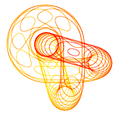Level set facts for kids
A level set is a cool idea in mathematics that helps us understand functions better. Imagine a function as a rule that takes an input and gives you an output. A level set is simply a collection of all the inputs that give you the *same* output value. It's like finding all the places where something is exactly the same.
Contents
What is a Level Set?
A level set shows all the points where a function has a specific, chosen value. Think of it like a map. On a map, you often see lines that connect places with the same height above sea level. These lines are called contour lines. Each contour line is a level set for the "height" function of the land.
Understanding Functions and Values
To get level sets, you first need to understand what a function is. A function is like a machine that takes something in (an input) and gives something out (an output). For example, a function could take your age and give you the number of teeth you have. If you're 12, the function might output 28 teeth.
Now, imagine you want to find all the ages where people have exactly 28 teeth. All those ages would form a level set for the "number of teeth" function.
Level Sets in Real Life
Level sets are not just for math class; they are used in many real-world situations. They help scientists, engineers, and even weather forecasters understand complex information.
Contour Lines on Maps
One of the easiest ways to see level sets is on a map. Topographic maps use contour lines to show elevation. Every point on a single contour line is at the exact same height above sea level. So, each contour line is a level set for the "elevation" function. If you walk along a contour line, you won't go up or down!
Weather Maps and Isotherms
Have you ever seen a weather map with lines connecting places that have the same temperature? These lines are called isotherms. Each isotherm is a level set for the "temperature" function. They show you all the locations that are, for example, exactly 20 degrees Celsius. Other lines on weather maps, like isobars, connect places with the same air pressure.
Sound and Light Waves
Level sets can also describe things that aren't physical lines. Imagine a sound wave spreading out from a speaker. The places where the sound is equally loud form a level set. Similarly, for light, the places where the brightness is the same form a level set. These are often called wavefronts.
Why are Level Sets Important?
Level sets help us visualize and understand functions that might be hard to imagine otherwise. They turn abstract mathematical ideas into something we can see and draw.
Visualizing Complex Data
For functions that have many inputs, it's hard to draw them on a simple graph. Level sets help by showing slices of the function at different output values. This makes it easier to see patterns and shapes in the data. For example, in computer graphics, level sets are used to create smooth 3D shapes.
Finding Maximums and Minimums
Level sets can also help mathematicians and scientists find the highest or lowest points of a function. By looking at how level sets are arranged, you can often tell where a function is peaking or dipping.
Images for kids
-
Intersections of a co-ordinate function's level surfaces with a trefoil knot. Red curves are closest to the viewer, while yellow curves are farthest.
See also
 In Spanish: Conjunto de nivel para niños
In Spanish: Conjunto de nivel para niños


